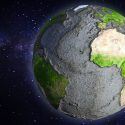The sky turns orange. A loud noise is coming from the distance and getting closer. You turn and see a wall of sand, rising meters (yards) above the ground, and you’re right in the middle of its path. What can you do to make it out alive?
Sand and dust storms are among nature’s most violent phenomena. Most of them take place in the Middle East and North Africa. However, in the U.S., these storms are common in the southwest in the springtime. They occur when strong winds pass over loose, dry sand or soil. As the storms lift debris from the land’s surface, they form walls of material that can be up to 3 m (10 ft) high. But in a monster sandstorm, it could rise to 25 m (82 ft) above the ground.
Why are dust particles so dangerous? What is a haboob? And how can sandstorms cause cancer?
Step 1. Crouch down to the ground
Sandstorms move fast at up to 80 km/h (50 mph). To seek shelter, you’ll need to move even quicker. But sandstorms can completely block out the Sun, making it hard to see around you and move. If you get caught outside, it’s safer to crouch down to the ground and stay there until the storm has left the area.
Step 2. Beware the dust
Dust storms and sandstorms are similar, but they’re not the same. Dust storms are way more dangerous because their particles are smaller, and they can be launched higher and farther into the sky. Dust from storms can travel up to 3,048 m (10,000 ft) aboveground. Depending on the weather conditions, dust can stay in the atmosphere for over 10 days. So it is crucial to protect your ears, nose, mouth, and eyes with fabric. In 2014, a global model assessment estimated that exposure to dust particles caused about 400,000 premature deaths worldwide in people over age 30.
Step 3. Watch out for thunderstorms
A heavy dust storm is called a haboob, which is the Arabic word for strong winds. Haboobs are giant walls of dust created by high winds rushing out of a collapsing thunderstorm. As a haboob builds, it may be impossible to see if the storm is less than 0.5 km (5/16 mi) away. Therefore, you should never drive in the middle of a haboob.
Step 4. Go green
In March 2021, Beijing, China had the most severe sandstorm in over a decade. Strong winds from Mongolia blew dust from the Gobi desert into Beijing. After the storm, 341 people were missing in Mongolia. Beijing’s air pollution has been increasing in recent years, and air pollution is already dangerous to humans’ health. And when air pollution combines with a sandstorm, it can be even more severe. When pollutants in the dust enter your body during a storm, they can lead to health issues like cancer.
Step 5. Don’t get comfortable
No matter where you live, storms can travel through continents. The yearly Sahara Desert dust storms cause 82 million tons of dust to storm out from the western Sahara. The wind storms levitate dust thousands of meters (yards) above the surface of the Earth, wisps the dust thousands of kilometers (miles) long, and mixes with the winds traveling west across the Atlantic Ocean and the Caribbean Sea. In the year 2020, a dust storm traveled through the Caribbean and then made its way through the southeastern United States. The storm was huge and earned the nickname “The Gorilla Dust Cloud.”
Step 6. Learn from legends
In the 6th century B.C.E., the Persian ruler Cambyses II conquered Egypt. But the legend says his army of 50,000 people vanished, buried by a dust storm. In the year 2020, researchers from Egypt’s Helwan University found clothing and artifacts that they believe are the remains of Cambyses’s army.
You’ve managed to survive not just any storm but a monster sandstorm. But don’t get too comfortable yet. Because it looks like there is a mega tornado on the horizon. Do you think you could survive that?
Sources
- “Sand And Dust Storms“. 2017. World Meteorological Organization.
- “Explaining The Monster Dust Storm Sweeping The Middle East“. 2022. Science.
- “Biggest Sandstorm In A Decade Turns Beijing Skies Yellow: “Like The End Of The World“”. 2021. Cbsnews.Com.
- “What Is A Dust Storm? | NOAA Scijinks – All About Weather“. 2022. Scijinks.Gov.
- “Dust Storms | Arizona Emergency Information Network“. 2022. Ein.Az.Gov.

















